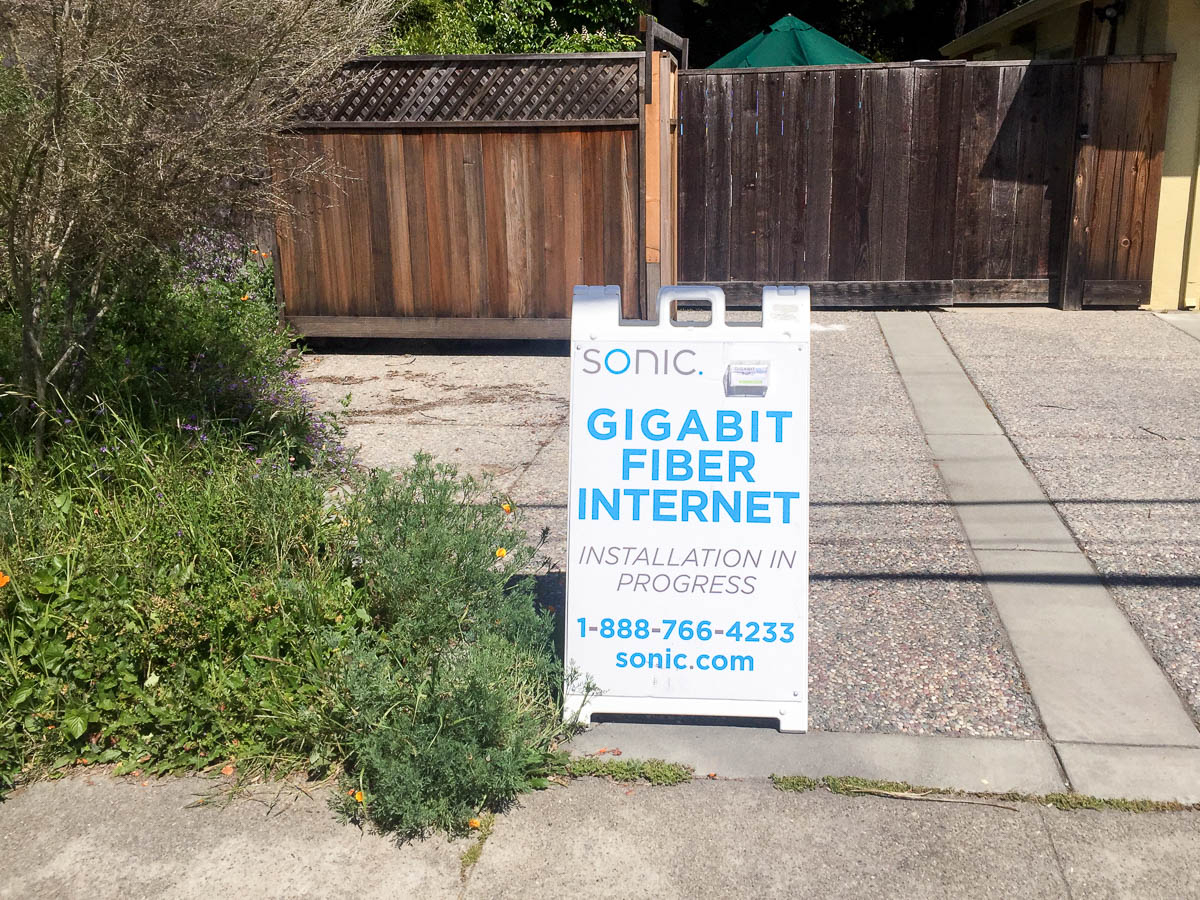Gigabit Fiber Has Arrived!
Posted 18 April 2016
Today, my household entered the true age of broadband.
Sure, we’ve been there for years, depending on how you define it. But this is a big leap from anything I’ve had in decades of internet use.
I started with 1200 bit/s modems, had 256 Kbit/s ISDN for years, and have been through generations of DSL and cable broadband, starting with less than 1 Mbit/s and moving up to today’s 34 Mbit/s from Comcast.
We currently have both Comcast (cable) and Sonic (was DSL, now fiber) service. Sonic’s DSL service delivered only about 13 Mbits/s, and we used it only as a backup.
In the selected areas in which they offer it, Sonic now provides gigabit fiber service for $40/month, including a phone line. This is an awesome deal. It is the same price Sonic has been charging for DSL, which is 50 times slower, and even that is a good deal.
In 2011, Sonic ran fiber through several Sebastopol neighborhoods, but it only hooked up houses on one street. My neighborhood was left on Sonic’s “coming someday” list. Five years went by, and I was wondering if I would ever get fiber.
Now it is here! The fiber runs from the pole to my house, into the room that is my office, and terminates optically in the first of three Sonic boxes. None is a modem of any kind! Ones and zeroes just flow on through as either light or as electrical levels.

Sonic put a sign in the driveway while they were doing the work, to complement the two loudly painted Sonic trucks parked across the street.
How Fast Is It?
But is it really gigabit? Not quite, but pretty darn good: more than 700 Mbits/s download, and 100 Mbits/s upload.

That’s about 20 times the download speed of the Comcast connection. If you use the Sonic DSL service as the basis for comparison, instead of Comcast, then the speed increase is more than 50X. Either way, it is a stunning upgrade.
But Does It Matter?
As spectacular as this improvement is on paper, how much difference will it make in the real world? That remains to be seen, but some things are clear.
Independent of the speed gain, fiber should be significantly more reliable than the old phone company copper wires that Sonic leases for DSL service, or the coaxial cable network that Comcast maintains.
In terms of speed, I expect it to make a big difference to me in a few areas.
I keep all of my files synchronized to Amazon’s S3 cloud storage service and/or to Dropbox. The 100 Mbit/s upload speed should make uploads go much faster when I have big files.
Ignoring all overhead, if we look just at raw, peak transfer time, 100 Mbits/s is 12.5 Mbytes/s. If I have 1 Gbyte of photos from a photo shoot, that will take about 1.3 minutes to upload. At 6 Mbits/s (Comcast upload speed), the transfer rate is 0.75 Mbytes/s, so 1 Gbyte takes 22 minutes. (Real-world figures will be lower, but we’re only looking for comparative numbers here.)
Now let’s suppose I have 100 Gbytes of photos and video from a vacation. That will take 2 hours and 13 minutes with the gigabit service, or about 37 hours with Comcast. You could upload 100 Gbytes in an evening using the gigabit service, but with Comcast you’d have to hope you could keep it going for nearly two full days.
Will Video Be Better?
In the past few years, the situation in which I most frequently experience what appears to be a bandwidth problem is when watching streaming video. The image may freeze up, get blocky, or drop to non-HD.
I’ve never been sure who to blame. It could be Netflix’s or Amazon’s servers that are providing the data, or it could be my internet connection, or it could be anything in between. We’ll soon see how much this has changed.
I remember watching a demonstration at an Intel analyst event in the early 90s, at which they showed jerky, postage-stamp-sized video on a PC screen. It did not move me at all; I thought, “who would ever want to watch video so tiny and low quality?”
It has taken almost 20 years of evolution in multiple areas, including faster processors, bigger memory chips, larger disk drives, and a much higher bandwidth internet infrastructure, but those postage-stamp videos are now movie-theater, big-screen quality, and I can stream them straight from my internet connection — a different video stream into every room in the house, if I wanted!
Bandwidth appears to have ceased to be a precious commodity, at least at my house.
